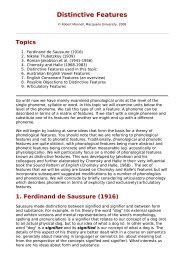Acoustic Waveforms Acoustic Waveforms Simple Harmonic Motion ...
Acoustic Waveforms Acoustic Waveforms Simple Harmonic Motion ...
Acoustic Waveforms Acoustic Waveforms Simple Harmonic Motion ...
You also want an ePaper? Increase the reach of your titles
YUMPU automatically turns print PDFs into web optimized ePapers that Google loves.
<strong>Waveforms</strong> and Damping (8)<br />
• Note that it is common to refer to both a<br />
sound and the system that generates it as<br />
possessing some relative degree of<br />
damping.<br />
Adding <strong>Waveforms</strong> & Phase (2)<br />
Here we can see the effect<br />
of adding two pure tones,<br />
one of 100 Hz and the other<br />
of 500 Hz. The 500 Hz tone<br />
has half the sound pressure<br />
level of the 100 Hz tone. In<br />
the bottom part of the<br />
diagram we can see the<br />
two pure tones as dashed<br />
lines. A simple addition of<br />
the dashed lines results in<br />
the unbroken line. The<br />
unbroken line clearly has a<br />
more complex pattern than<br />
either of the two pure tones.<br />
Adding <strong>Waveforms</strong> & Phase (4)<br />
• In the next slide we add together three<br />
waveforms with frequencies of 100, 200<br />
and 300 Hz. (Highest common factor 100)<br />
• They differ in the positions of the start of<br />
each wave cycle.<br />
• In the left image they all start at 0°.<br />
• In the right image they start at 0°, 90° and<br />
180° (going from the lowest to highest<br />
frequency)<br />
13<br />
15<br />
17<br />
Adding <strong>Waveforms</strong> & Phase (1)<br />
• So far, we have examined simple<br />
waveforms that resemble sine waves.<br />
When we plot a pure tone we can easily<br />
see its period (or frequency) and<br />
amplitude (sound pressure level).<br />
• The vast majority of natural sounds are not<br />
pure tones but are complex sounds that<br />
can be thought of as the combination of<br />
two or more pure tones.<br />
Adding <strong>Waveforms</strong> & Phase (3)<br />
• Note, in the previous slide, that the complex<br />
pattern repeats with the same period as the<br />
100 Hz tone.<br />
• 100 Hz is the highest common integer factor of the<br />
frequencies of the two tones (100 and 500 can<br />
both be divided by 100 to give an integer result).<br />
• The frequency of a complex wave is always equal<br />
to the frequency of the highest common factor of<br />
the sine waves being added to produce it.<br />
• The repetition frequency of the complex pattern is<br />
called its fundamental frequency (F 0).<br />
Adding <strong>Waveforms</strong> & Phase (5)<br />
14<br />
16<br />
18<br />
3
















